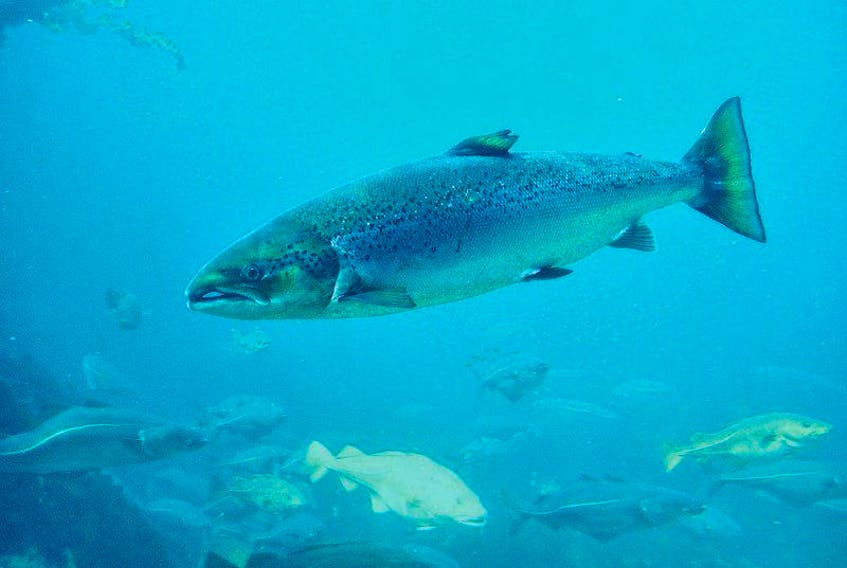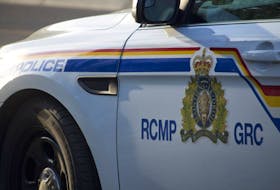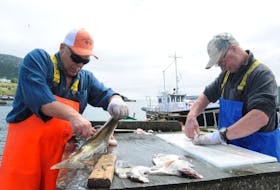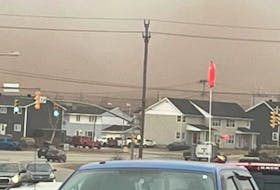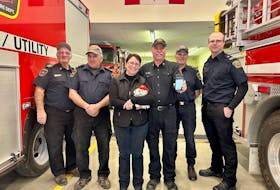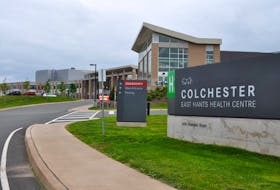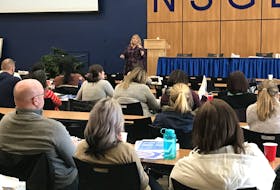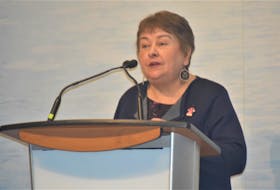GANDER, N.L — The Conne River salmon stock has reached the lowest level Ross Hinks has ever seen.
And if nothing changes soon, the director of Natural Resources for Miawpukek Mi’kamawey Mawi’omi First Nation believes his people could soon lose a species sacred to their culture.
“The days of study are over, we know there’s a problem,” said Hinks, who made his opinions known at the annual salmon stakeholders workshop in Gander Nov. 7-8.
The decline of the south coast stock has been documented by the Department of Fisheries and Oceans (DFO) Canada.
The 2018 Atlantic salmon fishway count identified 454 salmon compared to 677 the year before.
“We took 30 farmed salmon out of the river that year,” he said. “And people have been catching them for years now through the ice.”
-Ross Hinks, director of Natural Resources for Miawpukek Mi’kamawey Mawi’omi First Nation
The Conne River stock is down 76 per cent in comparison to its 2011-2015 five-year average.
Hinks sees a number of factors hampering the return of salmon, but his biggest concern is with sea survival.
Less than one per cent of salmon smolt leaving Conne River return as adults.
He feels the solution to rebuilding the stocks could be in the form of egg transplants, hatcheries, or fry grow outs.
While Hinks doesn’t deny it’s a costly venture, he’s been advocating for government funding to rebuild stocks.

By increasing what’s going out into the salt water should bring about stronger returns, he said. “One per cent of a million is a lot more than one per cent of 100,000.”
When the 2018 in-season review was released in July, DFO had stated it was unsure what was causing low sea survival for Atlantic salmon in the province. Hinks believes a contributing factor for his area is the presence of salmon farms along the south coast.
The Newfoundland Aquaculture Industry Association (NAIA) lists 25 aquaculture farms in that area.
Hinks feels the saltwater pen-based operations are established in critical habitat areas for salmon and, without adequate feeding grounds, the species can’t survive.
Furthermore, he said, wild salmon have to contend with risk factors such as infectious salmon anemia (ISA).
According to the Canadian Food Inspection Agency, ISA is a finfish disease. While there is no human health concern with this disease, it is detrimental to salmon. Depending on the strain of the virus, “it can result in death rates up to 90 per cent in affected (salmon) populations,” according to DFO.
Hinks said Conne River’s 11 river guardians do DNA and scale samples, but are unable to check for the virus because there is no funding to carry out the test.
He said guardians have also identified crossbreeding between wild and farmed salmon.
DFO has been studying the impact of hybridization following six escapes – three related to salmon – along the south coast in 2013, when more than 20,000 farm salmon escaped.
Hinks has seen examples of this himself. After the farmed fish escaped in 2013, he was able to obtain a permit to catch and retain farmed fish over 63 cm.
“We took 30 farmed salmon out of the river that year,” he said. “And people have been catching them for years now through the ice.”
In a few cases, Hinks said, they have come across second generation hybrids.
The year after the 2014 escape DFO collected 1,704 smolts – from eggs fertilized the year of the escape, and hatched in the spring of the year of sampling – from 18 area rivers adjacent to the escape.
Of that figure, 27.1 per cent of the sampled smolts contained aquaculture ancestry in 17 of the 18 rivers. Feral salmon (offspring of two domestic salmon) were found in 13 of the rivers.
The following year, the presence of feral salmon was essentially non-existent and hybridization was in decline.
Defending farming
Mark Lane, executive director for the NAIA, doesn’t feel aquaculture has impacted wild salmon as much as people like to believe.
“All Atlantic salmon rivers in Newfoundland and Labrador are in decline, and it’s been happening long before aquaculture and salmon farming ever existed,” he told The Central Voice.
Lane said a moratorium was placed on the commercial Atlantic salmon fishery in 1992 because of poor stocks, but commercial aquaculture has only been in the province for 25 years.
Furthermore, he said, it’s not just rivers near aquaculture operations showing decline based on the five-year average.
Instead, Lane attributes other factors, including interceptor fisheries (domestic and foreign), seals, retention angling, poaching and a changing climate, for the declines.
“I think a lot of people point the finger at aquaculture because they don’t understand what it is they do,” he said. “Atlantic salmon, the Conne River, it’s been long in decline long before a salmon farm existed at a commercial scale on the south coast of Newfoundland and Labrador.”
When it comes to habitat impacts, he said, farming produces high output in a small space, and doesn’t encroaching on the habit of wild salmon on the south coast because wild salmon can easily bypass the farms.
“Our fish are certified disease free before they are put in the ocean. It’s a naturally occurring pathogen, we contract it from the marine environment.”
-Mark Lane, executive director for the NAIA
“We try to set our sites away from salmon rivers or natural migratory patterns for wild Atlantic salmon,” he said.
The aquaculture industry has been feeling the effects of ISA as well.
The Canadian Food Inspection Agency has five listed reports of ISA in Newfoundland so far this year, up from three in 2017.
Lane doesn’t feel the farm related incidents have had any bearing on the wild stocks.
“Our fish are certified disease free before they are put in the ocean,” he said. “It’s a naturally occurring pathogen, we contract it from the marine environment.”
Even though the farmed salmon are vaccinated for the virus, they can still contract it.
“It’s similar to a flu shot,” said Lane. “It’s effective, but not 100 per cent all the time effective.”
Any fish showing symptoms would be followed by immediate action, he said.
“We have regular stringent monitoring programs,” he said. “If a fish, for example, tested positive for a case we would depopulation the cage.
“If a farm wasn’t run properly it could (have an impact), but the way we run things, no I don’t think so. We have two levels of veterinarian care, we are testing all the time. If we suspect a case that leads to diagnosis we would depopulation the farm at our cost.”
He doesn’t deny hybridization has taken place along the south coast, and admits escapes from salmon farms played a factor.
“That is something we accept responsibility for, it’s unfortunate, we don’t want to have escapes, but we still don’t know the fallout of that either,” he said.
The NAIA is working in conjunction with DFO to determine the effects of hybridization on wild stocks.
Lane added the brood stock for farmed salmon originates from wild Atlantic salmon.
“Is hybridization bad? We’ll continue to look at that,” he said.

Action needed
Either way, there’s still a very real problem with the Conne River salmon stock, and Hinks believes stock enhancement is the next step in recovery. And in doing so, he said, it can return a way of life to the Miawpukek Mi’kamawey Mawi’omi First Nation people.
The band’s Aboriginal food fishery agreement is in place, but it hasn’t been used since the 1990s.
“We were concerned about our harvest and how much of an impact it was going to have on what was returning to the river, and we got an agreement with the province to go in and angle,” he said.
But even angling has been halted for the past three years.
“If we don’t step in and do something, it’s going to be gone,” he said of the local wild salmon stock.
He’s recommending DFO make decisions to protect the species, not just for current-day fishers and outfitters, but for future generations.
If that means limiting angler retention limits and ending catch and release in the province, then he’s ok with that.
“It should be based on the number of fish that’s returning,” he said. “If you’ve got a lot of fish why not (allow for increases); (but) if you don’t have very much and are teetering on the brink of extinction, why fish?”
The stakeholder sessions in Gander pulled together those with a vested interest in salmon to discuss conservation, management resources and the stock itself.
Feedback collected is used to make a decision on the 2019 season angling season.
According to the DFO $3.7 million was invested in 2017-2018 for salmon science – to support salmon assessment and research – in Newfoundland and Labrador.
Jackie Kean, DFO resource manager, attended the sessions and understands Hinks concerns.
She said a working group has been established for Conne River and an action plan is being developed.
Augmenting the stock through hatchery-based programs is an idea that was raised in the sessions, she said.
“Those recommendations will be given serious consideration,” she said. “Salmon is a priority with the department, anything that comes out of it, we will consult with science and it will definitely be looked at.”
- Want in on the debate?
- Write us a letter to the editor and email it to [email protected]. Be sure to include a name, address and daytime telephone number where the author can be contacted. Letters should be no more than 300 words.
Related stories:
Central anglers question salmon science

